Ark of Bukhara
Ark of Bukhara
Ark of Bukhara (or the Ark Fortress) is a huge mud brick fortress that served as a residence of the Bukhara Khans and Emirs. It is a stronghold of the power and authorities that still stands as the main attraction of Bukhara and is the oldest structure in the city. The Ark was initially established in the 5th century AD and occupies the area of 4,2 ha reaching up to 20 m in height. Most of the Ark fortress is still not fully researched and definately not restored but it is being studied currently and new parts of it will hopefully be opened to public later.
Today it is a symbol and heart of Bukhara that has been the place of major events in the history of this city. The ark citadel used to be the residence of not only the ruler but also poets, scientists, and philosophers forming a town inside a town. It has endured many wars and has therefore absorbed bits and pieces of the entire history of the Central Asia. Bukhara Ark is also included in most of our Uzbekistan tours and in several Central Asia tours.
Bukhara Registan
You should start your visit to Ark from the vast main square of Registan, outside what is now the Ark’s main gate. Historically it served as both a slave market and public execution ground, though now it lies empty and as a safe, car free area for tourists and locals to walk around. There are more sights waiting for you west from Registan hidden in the several parks just a short walk away.
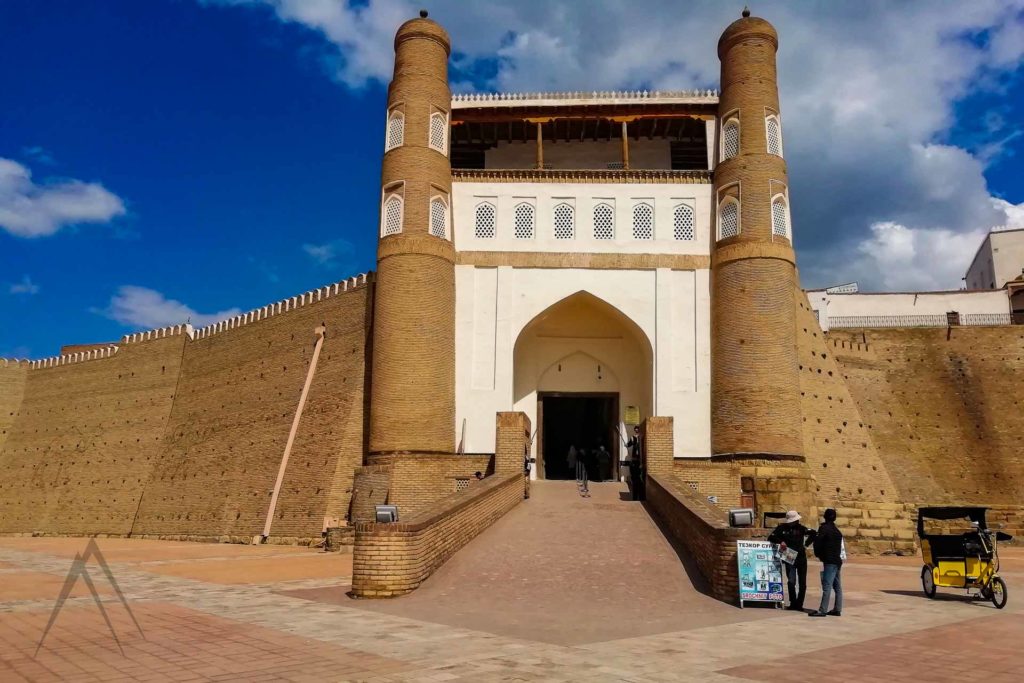
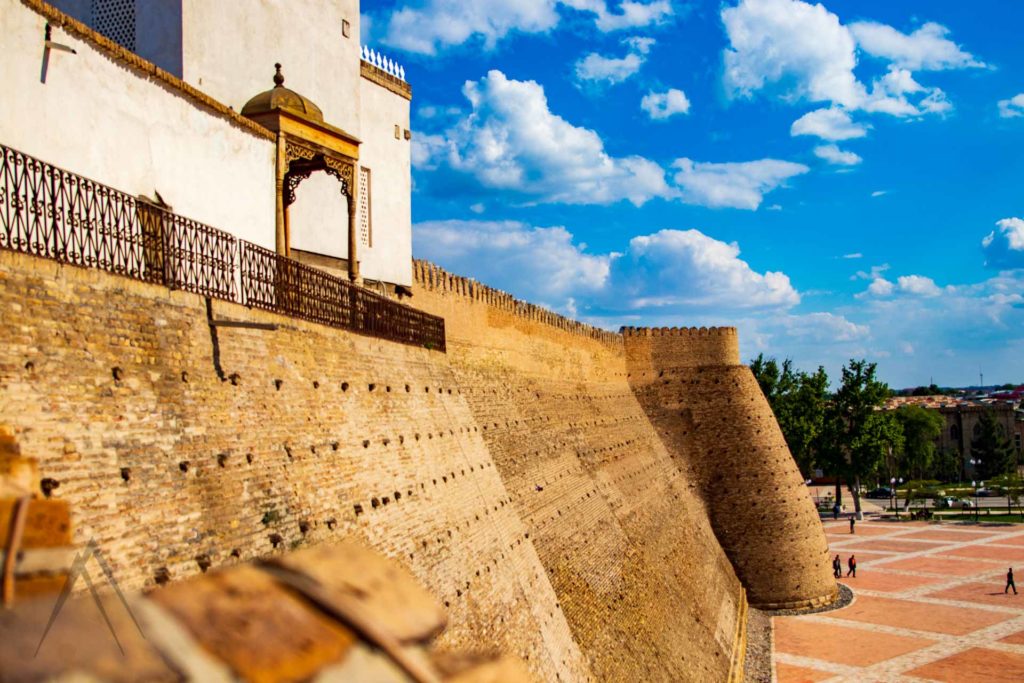
History of Ark of Bukhara
According to the archaeologists, Ark of Bukhara was built sometime between the 5th and 6th centuries AD. The Ark’s original rectangular structure included a palace, administrative areas, guardrooms, and a Zoroastrian fire temple. It became the center which the town of Bukhara was built around with the main functions of the town taking place within its old walls for defense purposes. Arabs built the first-ever Bukharan mosque here in 713 on the smoldering ashes of a Zoroastrian temple, to support physically and metaphorically the power of Islam over other faiths and their adherents.
Samanids and Karakhanids fortified the ark from the ninth to the 12th centuries with a series of ramparts. The Karakhitai and Khorezmshah destroyed and rebuilt it three times and finally, rather predictably, the Mongols crushed it in 1220. The Ark eventually began to take its present form in the 16th century under the Uzbek Shaybanids and all its present structures date from the last three centuries. A mosque, greeting hall, harem, music pavilion, jewelry workshop, clothing warehouses, treasuries and more were built.
In the 17th century, the emir’s throne room “Kurinishkona” was added, with a brick-paved courtyard that surrounded it on three sides by platforms supported by wooden columns. In 1753, the Uzbek Mangyt Muhammad-Rakhim tribe captured the throne, procuring the title of emir.
By this time, the Ark had grown to house not only the emir, his family and retinue, but also the whole range of government accessories, in a complex of over 3000 inhabitants, including a palace, harem, throne room, reception hall, office block, treasury, mosque, gold mint, dungeon and the slave quarters.
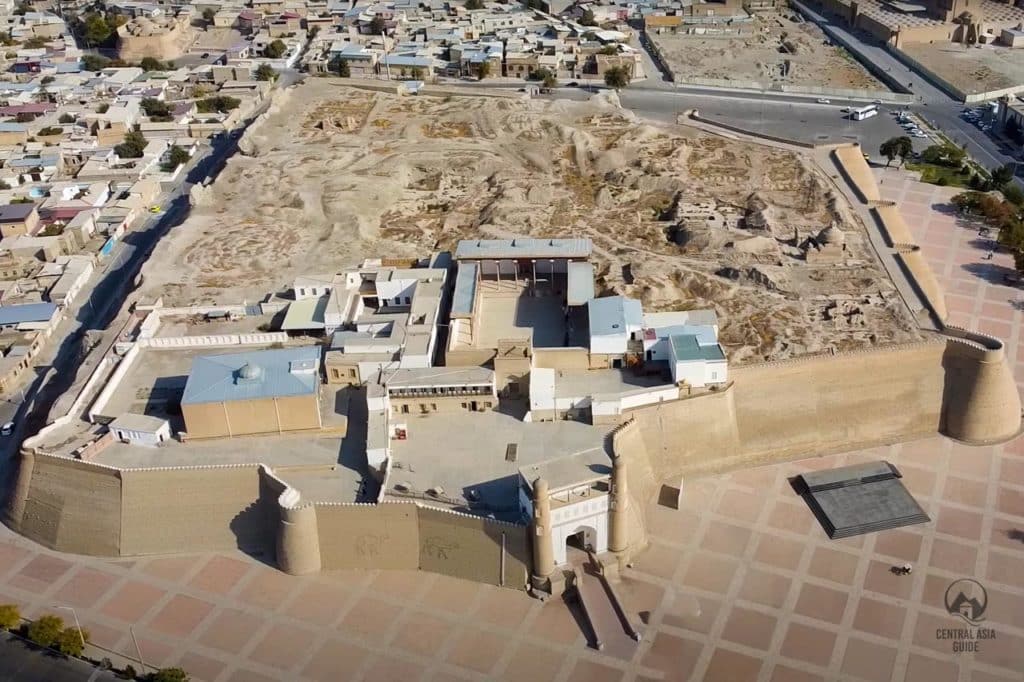
The Bukhara Khanate thus began to be called the Bukhara Emirate. Eight emirs of the Mangyt Dynasty ruled successively until 1920 when the Red Army invaded the city and annexed it to Russia. Throughout the Russian Civil War, the Ark was greatly destroyed by Red Army troops under the command of Mikhail Frunze. Frunze ordered the Ark bombed by aircraft, which left a large part of the structure in ruins.
There is also a belief that the last Emir, Alim Khan, (1880–1944), who escaped to Afghanistan with the royal treasury, ordered the Ark to be blown up so that its secret places, particularly the harem could not be desecrated by the Bolsheviks. Whatever survived soon became a natural target for waves of Soviet propaganda campaigns and was finally weakened and pacified into the town’s main history museum and archive.
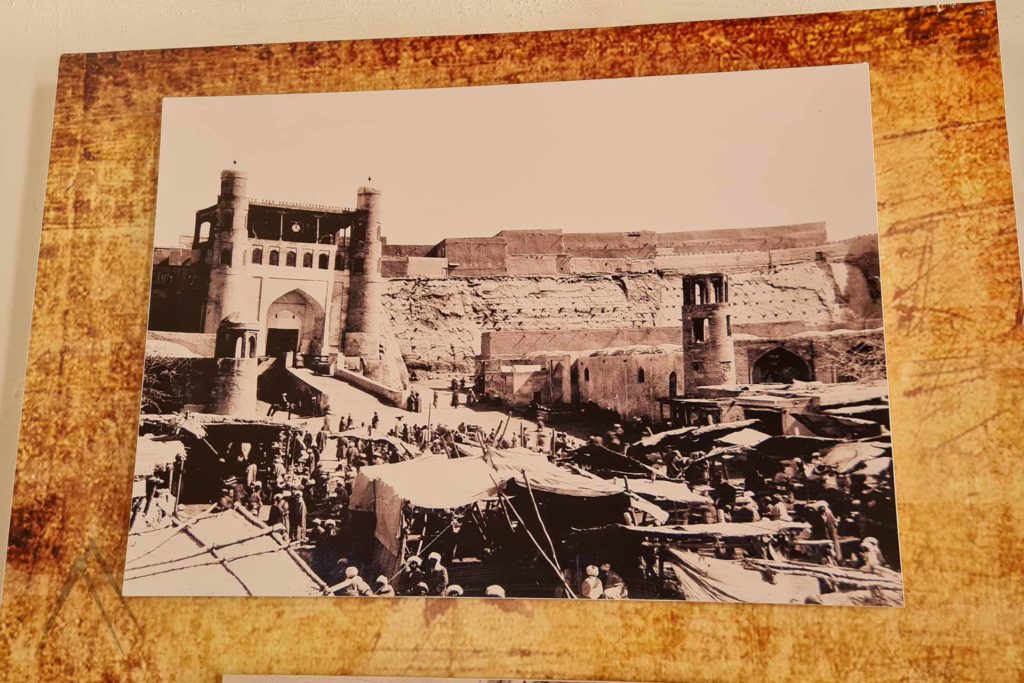
Hidden behind the cluster of restored museum buildings, still lie the heart and bones of the Ark and it seems that it will take a long effort to restore all of it. Thankfully, the front part of the Ark has already been restored and reopened to the public and there is an ongoing renovation project that will bring back to life other parts of the site as well, one section at a time.
What to see in the Bukhara Ark
Climbing the steep stone ramp and passing through the gateway brings you inside the Ark. There is a certain sense of shades of former glory, though as the renovation program continues and as more areas are restored and opened to the public, you should get a better picture of what life inside the citadel was like.

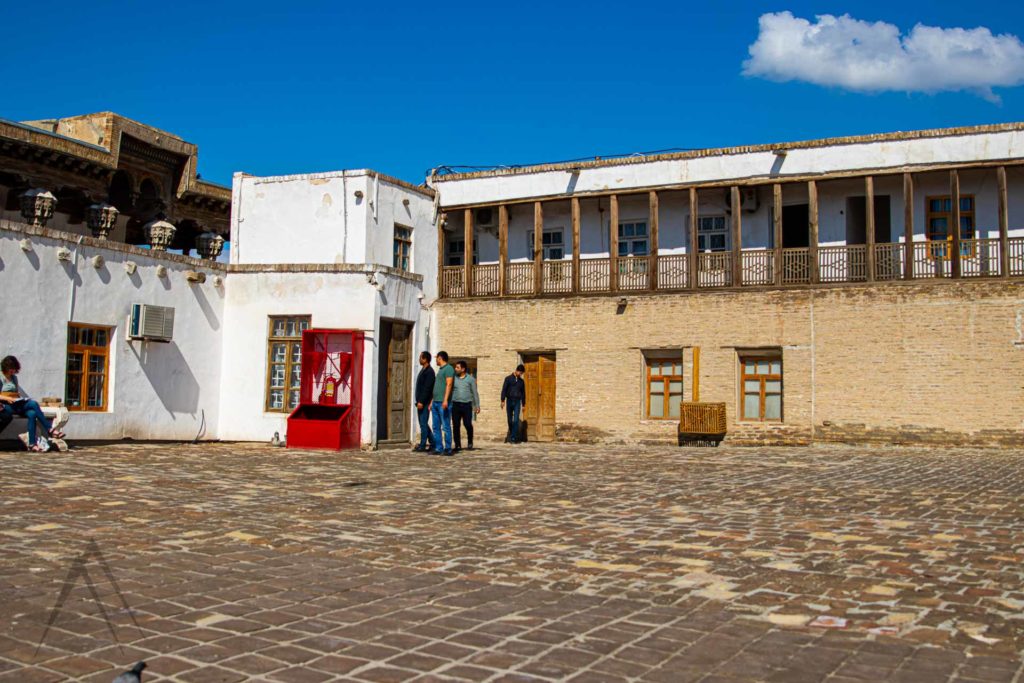
Bukhara Ark Western Gate
Access to the Ark goes through the Western Gate through an impressive entrance way built by Nadir Shah in 1742. The second, southern or Kalyon Gate has long-since been destroyed. There are two major items that once hung from this gateway. First one was a “khamcha” (six-stranded whip) to remind the people of the emir’s power and the second one a mechanical clock made by an Italian clockmaker, Giovanni Orlandi, who was captured by Turkmen slave traders in Orenburg, Russia in the mid 19th century. Orlandi earned himself a stay by offering to make the clock (at the time the only mechanical clock in Bukhara) for Nasrullah Khan but once it was completed, Orlandi was caught drunk and this gave Nasrullah the excuse he wanted to sentence the Italian to death. The skin on his neck was sliced off, and he was then beheaded.
Bukhara Ark archaeological Museum
The “Elchi Khana” administrative building is today the Regional Archeological Museum. The museum displays findings from the entire existence of settlements at this place. Moreover, the exhibition is constantly being replenished as excavations are being carried out in our time.
Bukhara Ark Throne Room
The “Kurinesh Khana” throne room, where the emirs were crowned and lifted onto their new throne whilst sitting on a silk carpet.
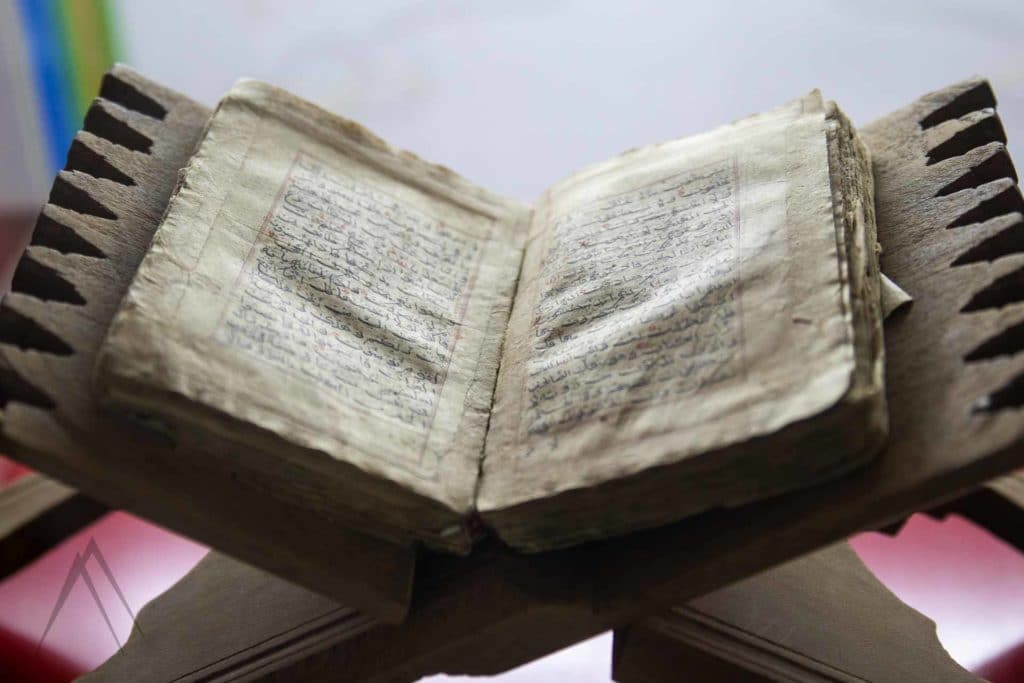
Reception and Coronation Court
The oldest preserved part of the Ark, the large Reception and Coronation Court. Its roof fell in during the 1920 bombardment. Coronations were held here until the 20th century when Alim Khan was coronated in 1910.
Bukhara Ark Local History Museum
Local History Museum has some fine royal clothes, including the emir’s coronation robes and an accompanying 20 m long turban and illuminating photographs of the Ark when it was still inhabited.
The Bukhara Ark Court Mosque
The Mosque now houses a small exhibition of calligraphy holding early Khorans and illuminated works of poetry. It includes the records from Navoi and Jami’s divan poetry and two pages from a Koran dating back to the 10th century. The court mosque with ornately sculpted pillars and a bright “mihrab” lies at the top of the walkway.
Zindan, the Emir's Prison in Bukhara Ark
The Zindan is the notorious Bukharan 19th century prison, hidden “behind” the Ark, next to the former Shakhristan Gate of Bukhara and northeast from the Ark. The prison was built in the 18th century. Zindan means “received” from Persian and has the meanings: “prison”, “dungeon”, “a hole for prisoners confinement”.
The large, dark building was a place for murderers, political prisoners, courtiers fallen from grace and 19th-century European guests all held in three diabolical cells, the most infamous of which was the Black Hole – a deep pit covered with an iron grill, accessible only via a long six-meter rope. The English missionary Henry Landsell was given a guided tour of the jail by his terrified guide in 1882 and observed how the poor prisoners, manacled and chained at the neck, went largely unfed, with those whose families were too poor to bribe the murderous jailers forced to beg for food every holy Friday through an exterior grating. Essentially, there were debtors and violators of religious instructions. The prison itself looked like a small fortress – brick external walls, stairs to the entrance, made in the form of an arch. The prison could hold no more than 40 people, and it reveals that the crime rate in Bukhara at that time was the lowest.
Today Zindan of Emir is converted into a museum that exhibits in one of the former cells. It displays the legal proceedings in Bukhara 19-20th century.
Shukhov Tower next to Bukhara Ark Fortress
Shukhov Tower stands at 33 meters high opposite to the gage of the Ark, on the other side of the road from Registan. It was originally built as a water tower in 1927 by engineer and architect called Vladimir Shukhov. He was a significant member of the Soviet industrial leap and the inventor of the hyperboloid structure of which the tower is a shining example. At that time about 200 of these types of water towers were built across the nation.
Just few have remained but enough of them still remain making Uzbekistan a rich hunting ground for the Shukhov-fanatic. The Shukhov Tower has lost its primary function and was not used for some time. In 1975, the wooden water tank burnt down, but for once, Uzbeks decided to keep their Soviet heritage instead of tearing it down. In the ’90s, a local entrepreneur installed an elevator and transformed the tower into a restaurant and viewing platform, but the elevator stopped working soon after and the business went bankrupt. The tower was closed for access for a long time, but in 2019 it reopened as a view platform that offers views to the Ark and the rest of the Bukhara old town.
Sights near Ark of Bukhara
Page updated 22.1.2023